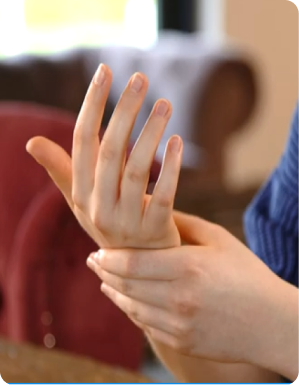What to do if carpal tunnel syndrome causes work restrictions? In most cases, the cause remains unclear. There may be pain, tingling and numbness in the fingers and thumb. Diagnosis is based on a physical examination and possibly nerve function studies or occasionally magnetic resonance imaging (MRI) or ultrasound scans. Symptoms can usually be treated with painkillers, splints, corticosteroid injections or surgery. (See also overview of diseases of the hands).

The carpal tunnel is a narrow passageway through which nerves and tendons run to the wrist, formed by adjacent tendons, ligaments and bones. The median nerve is located on the inner wrist and runs through the carpal tunnel. It is responsible for the sensations in the thumb, index finger, middle finger and on the thumb side of the ring finger.
Carpal tunnel syndrome mainly affects women between the ages of 30 and 50 and can affect one or both hands.
Carpal tunnel syndrome work - causes
Carpal tunnel syndrome is caused by compression (entrapment) of the median nerve due to swelling of the tissue around or in the carpal tunnel or by connective tissue cords that form on the inner wrist. Pregnant women, diabetics, people with hypothyroidism, certain forms of amyloidosis, rheumatoid arthritis and people who perform vigorous movements with outstretched wrists at work have an increased risk of carpal tunnel syndrome. Prolonged vibration or repetitive work with strong wrist movements, such as the use of certain power tools, have also been linked to carpal tunnel syndrome. In most cases, however, the causes remain unclear.
The correct keyboard posture
Incorrect posture at the computer keyboard can cause or exacerbate carpal tunnel syndrome. To avoid injury, the wrist should be held straight so that the line from the hand across the joint to the forearm is straight. The keyboard should be low enough so that the hand is lower than the elbow. A pad can be used to support the wrist.

Symptoms of carpal tunnel syndrome
Carpal tunnel syndrome causes unusual sensations, numbness, tingling and pain in the first three fingers and the fourth finger on the thumb side. It can affect the entire hand and occasionally cause pain and tingling in the forearm.
Sufferers are sometimes woken at night by pain, numbness and tingling in the hand. These symptoms can be relieved by shaking the hand.
Over time, little-used muscles on the side of the thumb can weaken and atrophy.
Diagnosis of carpal tunnel syndrome
- Medical examination
- Sometimes nerve conduction tests
- Occasionally imaging procedures
Carpal tunnel syndrome is usually diagnosed on the basis of an examination of the hand and wrist. Additional examinations such as nerve conduction studies or advanced imaging techniques such as MRI or ultrasound may be performed, especially if surgery is being considered.
Treatment of carpal tunnel syndrome
- Splints
- Curpal
- Treatment of the underlying condition
- Sometimes corticosteroid injections
- Occasionally surgery
Relief can be achieved by avoiding excessive strain on the wrist or pressure on the median nerve and by positioning the computer keyboard correctly. Wrist splints to keep the wrist in a neutral position (especially at night) and mild painkillers can also help.
Wrist splints can alleviate the pain caused by carpal tunnel syndrome as they keep the wrist in a neutral position.
Treatment of underlying conditions such as rheumatoid arthritis or hypothyroidism can occasionally relieve symptoms.
In cases of severe pain or numbness, or if muscle weakness or atrophy is severe, the pressure on the median nerve can be relieved by surgery. This involves loosening the connective tissue cords that are pressing on the median nerve.
If carpal tunnel syndrome is diagnosed, it is important to act quickly and take appropriate measures to treat the symptoms. Symptoms can vary from patient to patient and range from pain in the fingers to numbness in the wrist and hand. The carpal compression test can play an important role in diagnosing the syndrome, as it can identify possible constrictions or irritations by applying pressure to the nerve in the carpal tunnel.
Sources
1st German Medical Journal - https://www.aerzteblatt.de/archiv/188575/Karpaltunnelsyndrom-Manuelle-Therapie-ist-ueber-ein-Jahr-so-wirksam-wie-OP
2. focus.online - https://unternehmen.focus.de/karpaltunnelsyndrom-symptome.html







Leave a comment
This site is protected by hCaptcha and the hCaptcha Privacy Policy and Terms of Service apply.